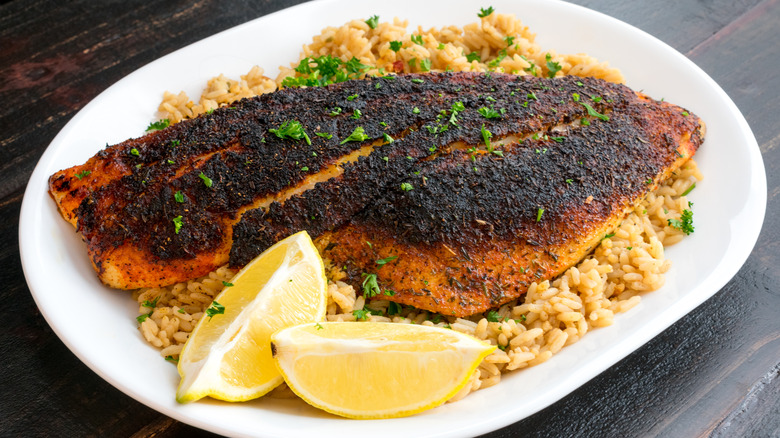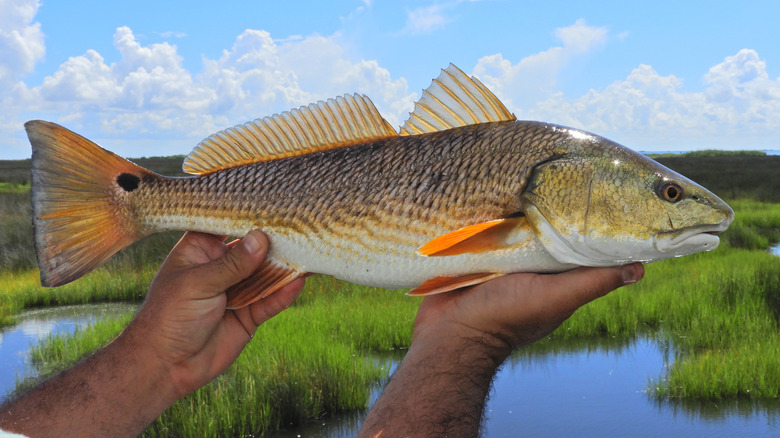The Cajun Dish That Was So Trendy It Resulted In A Fishing Ban
If a species is so delicious that it gets over-hunted, surely foodies would understand waiting to enjoy it again until population numbers reach a safe level... right? In the case of the bluefin tuna, the answer to this question revealed itself in real-time across a global dining market: From many food lovers, the answer was a harrowing "no." Bluefin tuna is so sought-after for sushi and sashimi that overfishing has reduced the fish's population by at least 80% over the last 80 years, as reported by Tulane University. Luxury sushi chain Nobu caught serious backlash for continuing to serve bluefin while it remained on the endangered species list during the early-2010s.
When you think about chowing down on an endangered species (if you can even imagine it at all), there's probably a good chance that this type of elite fine dining is exactly the sort of arena you might have in mind. It seems akin to eating foie gras or owning an exotic tiger as a pet — a perhaps-gratuitous show of wealth reserved for folks with enough disposable income to kindle a house fire. Indeed, a meal at Nobu runs for upwards of $100 a plate. But, believe it or not, there was one non-luxurious, seemingly ordinary Cajun dish that was so trendy it resulted in a fishing ban.
Blackened redfish was dangerously delicious
When you think of Cajun cuisine, dishes like beignets, gumbo, or red beans and rice might come to mind. But how about blackened redfish? New Orleans chef Paul Prudhomme was a champion of Cajun cuisine during the 1980s. In his cooking show "Always Cooking!," the chef would regale viewers with stories from his own childhood growing up on a farm in Louisiana. Super fun, right? Not if you're a red drum fish. Prudhomme published a recipe for blackened redfish in his 1984 cookbook "Louisiana Kitchen." The recipe outlined a decidedly simple dish: redfish filets dredged in butter, rubbed down with cayenne, thyme, and paprika, then hit with a pan-sear to blacken. It might have been an understated recipe, but Louisiana foodies couldn't stop talking about it. Seemingly overnight, the blackened red drum became a famed delicacy of Cajun cuisine.
Not to be confused with Acadian redfish or the scary door paint from Stanley Kubrick's seminal "The Shining," red drums are highly sought after for their mild, slightly sweet, firm flesh, comparable to red snapper. Less than two years after Prudhomme's cookbook was published, a New York Times headline declared, "U.S. Bans Red Drum Fishing in Gulf." According to the National Marine Fisheries Service, 2.7 million pounds of red drums were fished out of the Gulf in 1980, a figure which rose to a staggering 8.3 million pounds in 1986. So, whatever happened to the species? And is the blackened redfish craze dead?
The future of blackened redfish
The U.S. Department of Commerce officially banned red drum fishing in the Gulf of Mexico for the year 1987. Even commercial fishermen were limited to a 100,000-pound incidental catch. Today, redfish remain a protected species in the U.S. In some states, you're allowed to catch them for yourself, but there are strict rules about how many you're allowed to keep. Daily catch limits range from zero to five at most. (In Louisiana, fishermen are allowed a maximum of five redfish per person per day.) In other states, catching red drums, even for personal use, is forbidden.
According to Mississippi State University, catching and selling red drum fish is illegal in Texas, Louisiana, Alabama, and Florida, as well as in federal Gulf waters. It is currently only legal to fish red drum fish commercially in Mississippi, where the ban has significantly impacted the state's fishing industry. The supply remains far below the level of consumer demand — but, in the name of population conservation, that's also kind of the point. If you want to try out Cajun blackened redfish for yourself, make it with red snapper instead.


